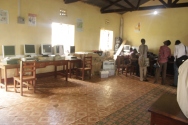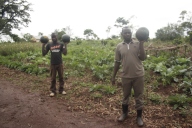The introduction of universal primary education in 1997 was one of Ugandan government’s main policy tools for achieving poverty reduction and human development. Its core objective was to provide the facilities and resources to enable every child to enter and remain in school until the primary cycle of education is complete. The UPE program in Uganda demonstrated that a poor country with a committed government and donor support can fight poverty through ensuring universal access to education for its citizens (odi.org.uk). To build on the success of this scheme, the government went ahead to introduce universal secondary education. But critics argue that the theory based approach in both schemes is not responsive to the actual needs of a developing country since students are trained to be job seekers. What are the available options?
During mid-November last year I visited Abilonino Polytechnic instructors’ college in Kole District in Northern Uganda. As a team of architecture students from Makerere University we were led by a Dutch architect. Our problem is to research, consult and propose designs for new facilities for the college. The campus is due to be given a major facelift under project collaboration between the Ministry of Education & Sports and the Belgian Technical Co-operation.
Twenty kilometers west of Lira town we branched left from the highway on a muddy road that crossed a large swamp. Occasionally the bus danced on the slippery murrum. We dragged on. Smiling children on the roadside, stooping adults working their gardens all waved and cheered us on. I would wave back, beaming with soulful exhilaration. There is something about rural landscapes and the country side that spoke to my spirit. The communities here are primarily subsistence agriculturalists and homesteaders. I was having a great time but the road had, undoubtedly given us a first hint on some of the challenges that the college has had to cope with.
The guided tour of the college lasted almost two hours. I was gobsmacked by the inadequacy of learning facilities, astonished by their dilapidated state. At the administration block, the vision statement stands boldly on the front façade, “To be an international center of excellence in technical teachers’ education and training”. I wonder how much of that vision had been accomplished.
The college buildings are clustered around open rectangular courtyards which felt rather authoritative and less contemplative. At the staff room, a group of tutors are seated around, their faces buried in books or laptops. One bespectacled tutor mumbled a simple ‘hello’ to us. This room doubles as a boardroom and dining area for the staff. The space seems to be utilized optimally and alive acoustically. The next two rooms on the same block are allocated for a carpentry workshop and building materials’ lab. On the inside these rooms are but empty.
‘There isn’t a library’, our guide said emphatically. There is a store then 3 more half-furnished classroom units. At the end of the block lies a computer laboratory accommodating 10 desktop computers rarely used by the students. The building has naked brick walls. Mosses grew wildly on the damp, exposed plinth walls. I figured it’s perhaps due to a simple construction flaw of missing splash aprons. Some classrooms don’t have windows and doors so interiors become extremely uncomfortable during inclement weather.
It was a quarter past one when we headed to the dormitory section. Some students were out in compound doing laundry. This section has a single block divided into 5 units. Four of these are for male students. Each unit is an open-plan room with 2 rows of double-decked beds. I thought this only happens in elementary boarding schools. Where is the privacy? Rooms are exceedingly congested. How about safety? The air inside is suffocating because most windows are blocked by the beds.
An aroma of boiling meat mingles in the air. It begins to tickle my noise from the direction of the kitchen. It’s Saturday and beef is on the menu. Beyond the kitchen there are accommodation units for senior staff, and then beyond are school farms. We passed by a piggery, a poultry house. In the gardens cabbages, watermelons, maize, cauliflowers, tomatoes, and weeds are springing forth, fruiting (except for the weeds) beautifully. I never saw fields look or smell so fresh. The vast green is punctuated by the darkish, course-grained, loamy soil. Wind seeps through the eucalyptus trees at the boundary of the gardens in horizontal gusts. Our guide makes an expected announcement: the gardens supply the kitchens often.
“This school could become a quintessential model of self-sustainability,” I thought to myself. I conjured up images of a campus capable of supplying its kitchens with food from its gardens. I envisioned solar panels on the roofs of classroom blocks that are capable of being completely naturally ventilated. I saw biogas plants on the periphery of the school, running on plant and animal residues collected within. I pictured tractors tiling the school land. With mechanization the college’s agricultural productivity could be rapidly scaled up, and surpluses perhaps sold to the community. ‘Machinery has become the new Messiah,’ Henry Ford once blasphemed. The principles of permaculture would definitely work here. Permaculture is an ecological design system for sustainability in all aspects of human endeavor. It teaches us how to build natural homes, grow our own food, catch rainwater, and build communities and much more. (permaculture.org)
At the moment students are sharing a borehole with surrounding community. The water supply has become intermittent because the water table has since changed. It is sheer bravery for these students to hang on in this situation because the borehole is located 300m away from the school premises. Yet in the wet season decent rains fall in this area. Could the new designs provide for rain water harvesting and storage? Could we tap into the wind energy to drive the water pumps?
We were heading back to the staff room when we walked diagonally across the courtyard. Midway a group of male students sat lazily, others perhaps legitimately on chiseled logs placed under an elaborate, indigenous fruit tree. The intensity of their voices plummeted as we drew nearer. These spaces are dubbed ‘embassies’ and are dotted across the entire courtyard. The culture of embassies was very unique to this school’s social fabric and we looked forward to celebrating them through our designs. Each ’embassy’ accommodates meetings of groups of students from a particular tribe or region in Uganda, offering a platform for both casual and formal conversations. For the former, topics range from local politics to international sports (mainly European football). Speaking without notes, with an authority and clarity that silenced his audience, a student addresses his mates. I listened passively, half drawn to the voice of Rihanna and JayZ singing. Other students are in the multipurpose hall relaxing and slaying the passage of time. Their mind and body tuned to MTV Base.
The existing situation at Abilonino Polytechnic College appears to be one of problems of mammoth proportions. But I see immense possibilities of turning these problems into opportunities and forging solutions. Even after the design stage there might still be long walks through policy nags and implementation huddles but the windows of possibility have now sprung open. My desire is that as students we may produce proposals that engage with issues beyond the brief, produce architecture that transcends the specifications of the site. I also desire that our proposals may not only make a contribution to local and regional concerns but become a pillar towards the realization of the school’s vision. Hopefully this college will begin to challenge the current social mindset that portrays vocational training as an option for academic failures or a last resort for those who cannot afford university education.






The writer, Benard Acellam, is a student of Architecture at Makerere University in Kampala and a volunteer at Rebuild Global.






You must be logged in to post a comment.